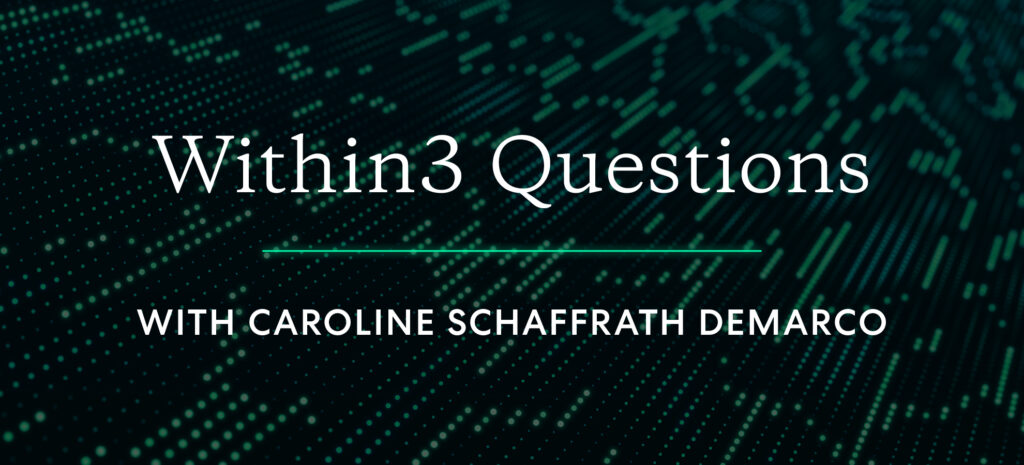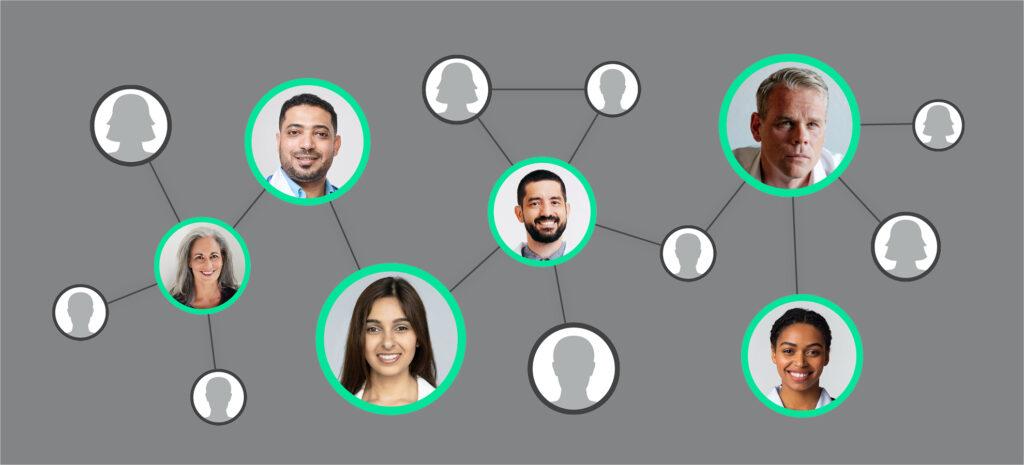In our latest podcast, we’re joined by Caroline Schaffrath Demarco, Director of Insights Strategy and Innovation at Within3, who explains that pharma social media listening can grant teams access to a layer of insights they might otherwise miss.
By capturing unscripted and unprompted reactions to data releases and presentations, social listening can help organizations make more informed decisions and reduce the “fear of missing out” from limited resources on the ground during the event.
Listen to the 15-minute episode to learn how social listening in pharma helps teams follow the legitimate scientific exchange around congresses, enables them to capture conversations and reactions that happen beyond the walls of the event, and even provides a way to look back in time and understand changes and fluctuations in trending topics.
Podcast transcript: Within3 Questions with Caroline Schaffrath Demarco
Within3:
Welcome to Within3 Questions, a podcast where we ask one interesting person three interesting questions about life science, technology, and insights. I’m your host, Sarah, and today our guest is Caroline Schaffrath Demarco, Director of Insights Strategy and Innovation here at Within3. Welcome, Caroline.
Caroline Schaffrath Demarco:
Thank you, Sarah, for having me.
Within3:
So Caroline, today we’re discussing social listening for pharma and life science companies. And historically, this concept has been a little bit tricky for the industry because there are stringent restrictions on public communication and promotion. And in the UK for example, just recently, pharmaceutical companies got some long-awaited guidance for social media, which reportedly had become a major compliance headache for drug developers. But that’s really focused on engagement, engaging with the public portion of social listening or pharma social media, rather, they can get a lot of benefits from social media actually by listening rather than speaking. And one of the best use cases for pharma and social media listening is medical congresses. And since we’re coming up on congress season, we wanted to talk to you about what makes social listening and medical congresses such a great match.
Caroline Schaffrath Demarco:
Thank you so much. Question of the hour, <laugh>. So they make a great match because they’re able to really listen to those reactions, opinions, and the takeaways from the congress social monitoring. Immediately, congresses are very important to key opinion leaders, to healthcare providers, and even those that are not attending the congresses. And so there’s this very rich pool of data coming to life, literally <laugh> as the congress goes by. And that can be leveraged for the decision-making.
And to echo your point before, yes, the industry is highly regulated. There are restrictions that are focused on engagement, but that’s not really what social listening is about. And so there’s nothing wrong with us following that massive amount of legitimate scientific exchange that happens around congresses. And social listening gets you to those unprompted unscripted reactions to the data releases, for example. And that can be huge for, for companies in life science.
Within3:
Can you talk a little more about that, about the value of, of exploring this on unprompted and as you said, unscripted conversation that happens online?
Caroline Schaffrath Demarco:
Absolutely. So we have seen HCPs really share their thoughts on, for example, whether or not new data that is being released of the congress would have an impact on practice patterns and on patient care, right? On Twitter, for example, there’s often debates, there’s various opinions. Peers are discussing and reacting to that data. So it’s become really common practice to see live tweeting of a presentation. For example, you have your congress ambassadors who really go above and beyond. I’ve seen full diagrams of treatment decision trees on Twitter and people commenting on, you know, whether or not that was a good approach. So it can become a very rich source of, of insight for life sciences and, and to be able to, to make decisions off of that.
Within3:
So when we were talking, talking earlier in preparation for this chat today, you mentioned that there’s a, there’s almost like an alternate reality going on. Can you explain what you mean by that?
Caroline Schaffrath Demarco:
Yes, I love that question. Social media and social listening basically give you another reality of dimension into the congress. So if you’ll indulge me, which you are, thank you very much, <laugh>. There is the congress that you’re experiencing live in the room. You’re either live in person or on a virtual setting, and there’s the chatter about the congress happening online in a separate space. So it’s almost unfolding as the congress is taking place. These conversations are happening and going beyond the walls of the congress into the internet. So you’re able to really capture what is the science that is resonating with attendees, who’s talking, what channels are they using?
And very important that we can glimpse from social listening is who and what is having an impact online. You’re able to then reconcile all of that data and understand what did I experience at the congress? What did I, what did my team experience when speaking to stakeholders at the congress? And what am I seeing online and does this match? And if it does, that is, that is great. If it doesn’t, you can probe further. Right? And even if it does, it leads you into the next question, right? It confirms all of your assumptions basically. So there’s a lot of different ways that social listening can be thought of.
Within3:
So one of the things that you’ve mentioned before is with data you can always look back. Can you explain a little bit more about what that means in the context of a medical congress and, and why that ability to look back is important to pharma teams?
Caroline Schaffrath Demarco:
Yeah, absolutely. What it means is that you can really reduce the levels of FOMO <laugh>, you can reduce that fear of missing out. In all seriousness, say that you’re planning to release data at ASCO 2023, and while you want to track what is happening there and the reactions, you just don’t have a good baseline of what was it like back last year. And with data, you can do that you’re able to look back and track, say, ASCO 2022 compared to ASCO 2023 and answer, is what I’m doing making an impact, right? Is the performance of my team or all of the tactics that we have deployed, were they impactful online, you’re able to also compare and contrast, right?
We’ve done compare and contrast case studies about these congresses and how has perception about a different treatment option, for example, changed year over year. Another scenario that I find interesting is say that you had five meetings that you wanted to cover on a year, but you had to prioritize. You didn’t have the budget to attend all five, and so say that you missed the congress or two. And social listening can really help you bridge that insight gap and give you something where you had nothing to act upon, right? So, and it is a very cost-effective way to do that as well.
Within3:
That sounds like such an important dimension as people deal with budget restrictions and, and maybe, you know, people being spread thin that some people don’t have to be sitting heads down, you know, watching a Twitter feed roll by. They can, they can sort of let it run in the background.
Caroline Schaffrath Demarco:
Absolutely. That’s a very valid point, Sarah. And so time is, time is limited, time is precious, both, both for the, you know, for pharma teams that have usually lean teams and have a lot of, a lot of tactics running in parallel at these congresses. And so you really don’t get to grow through Twitter feeds or try and, and pull all of that manually. I mean, you really need social listening to be able to do that in bulk to, to collect right? All of that information that is, that is relevant to you. Because one of the biggest challenges really is to understand what and who is important. And so if you don’t have a good way to, to do this in at scale you’re going to be perhaps running around in circles and, and spending a lot of your time, a lot of your team’s time, right.
And perhaps even wasting that precious time with your KOLs, right? Right, right. That’s another aspect of it, because time is like, like we said, time is limited, so a lot of your Ks are often unable to, to meet with you.
And so what social listening can, can do for you is that it can paint that high level picture so that you walk in better informed when you’re speaking with your experts, and these conversations with these key stakeholders can be le can be leveraged to go a layer deeper. So instead of you asking, did you see the data or what did you think of it, it’s more about why was the reaction that way? Why is that they think, you know, why did they react? What were they, what were their sentiments about the data being released?
So one interesting comment that we had a client shared with us that as her team tried to approach and engage a KOL at the congress, he said he didn’t have time, but as he was walking down the hall, he said, if you want to know what I think about your product, just follow me on Twitter <laugh>.
And so we thought that was, that was pretty great and honestly pretty accurate. We see a whole lot of that.
Within3:
You had mentioned earlier something about real-world data and real-world evidence, and this is something that, you know, we talk a lot about in our own, in our within three publications and that we, that we see the industry talking about a lot too. Can you say a little bit more about how that might tie into social listening?
Caroline Schaffrath Demarco:
Yes. Now that is a, that is a very, very good point, and it is very closely related because one angle that we can think of, of social media is the social media post can be seen as a source of real-world data, and it can help build the real world evidence story. So although that data set can be messy in nature, because obviously we’re talking about social media pharma here it, pharma social media is here to stay <laugh>, it’s here to stay. And it is only going to grow. I mean, the uptake has been tremendous, and more and more folks are using it. And as the younger generations are getting comfortable leveraging social while they’re practicing or researching, right, I think we’re gonna see even more of that come to life. And so we need to acknowledge social as a source of market insights.
It’s really become a must-have rather than a nice-to-have. It’s, it, it if you’re doing social listening, it allows you to again, probe further and ask more poignant questions and get, get deeper than that high-level surface data that social can provide you. What are the trends, who’s stalking, what platforms they’re leveraging, what is having impact? And you can take all of that in and ask and, and, and ask for the next question and get better time with your HCPs. Right? And it also, the way that you communicate back to your stakeholders, it can really show you’ve been listening.
Because if you’re in tune to what providers, experts you know, advocates or even patients and caregivers have to say, you can speak to them in a way that shows that, that you’ve been listening and that you care because hey, if they care to say it to the world, I’m sure they hope you listen. And to do this at scale, you really need social listening.
Within3:
That’s a really good example of what you were talking about earlier with the alternate dimension. I think there’s things that people say, you know, in meeting rooms or in informal situations, and then there’s things that they say online or in more casual forums, and it seems like a really important way to, to get that dimensionality.
Caroline Schaffrath Demarco:
Absolutely. Absolutely. I think that, you know, as, as we’re able to get that, that HCP engagement to that data, for example, if we’re think, if we’re thinking specifically of those medical congresses and the data being released, you know, the, as the data from the moment that data is being released into the world, it’s making an impression and, and there’s this meaningful exchange and this sentiment and open access to collaboration where, where folks are shaping their perceptions, their biases, you know, it, it’s very critical to be aware of such psychological phenomenon because they’re forming in real-time and you’re able to then act accordingly to those reactions and to that sentiment, right?
Because truth be told, I mean, we need to, you know, we’re releasing data for it to have an impact in the real world. This data needs to be socialized with HCPs and that online exchange around the congresses is very big part of how that, how that starts and that scientific narrative really is shaped in real time right? As it’s released at the congress. So it’s quite interesting.
Within3:
So I always like to offer something for listeners to sort of take away and, and think about or that they can act on. After listening today, if a company or if a team isn’t using social listening as part of their congress strategy specifically, what can they do now? Where should they start?
Caroline Schaffrath Demarco:
Thank you for asking that. And, and I see that there’s a lot of, you know, there are a lot of teams that struggle with bandwidth and, and wanting to, to do a lot of diff a lot of different tactics and wanting to, and understanding the importance of this, but simply being overwhelmed about how do I even start? Right? And, and this can be a very simple process for teams to deploy. If you select a good technology partner to do this with you, it really doesn’t have to be a, a large undertaking. And what I like to say is that we need to contextualize and put social as being part of that puzzle.
There’s a lot of, a lot of the difficulty in processing all of this data and really extracting the insights lies in picking out who and what is important. And so you really need to have a strong technology partner to be able to help you filter all of that data and focus on what is relevant to you, and to do that quickly and that scale, again, you’re, you’re really not able to do this as a manual process and keep up with it, especially with everything else that is running in parallel at these congresses. So I guess the bottom line is that I would encourage the listener to, to engage a team that you trust and, and really try and find someone that provides more than social listening.
Because once again, once you put all of those pieces together, the faster you can integrate the pieces of information that you’re getting, say live at the congress via social listening, that you’re listening from your team and you integrate and basically corroborate all of that data and then get to the silhouette, the faster you’re able to do that, the better off you are. Right? And, and social listening can really add color to that story of yours because it provides you with that verbatim really content. They’re able to go back to your team and say, look, this is what we, this is what we heard about our product, or this is what we heard about our competitor. So it can be very powerful. But when used in, in synchrony with, with other tools,
Within3:
Well, I think everybody’s interested in, in getting more information and being able to use it more effectively. And I thank you very much for joining me today.
Caroline Schaffrath Demarco:
Thank you so much for having me, Sarah. It was really a pleasure.
Within3:
And thanks to everybody listening as well. Join us again soon for another episode of Within3 Questions. Until then, you can visit us at within3.com or follow us on Twitter or LinkedIn. Bye for now.






